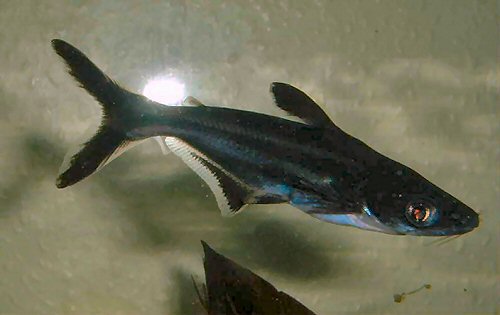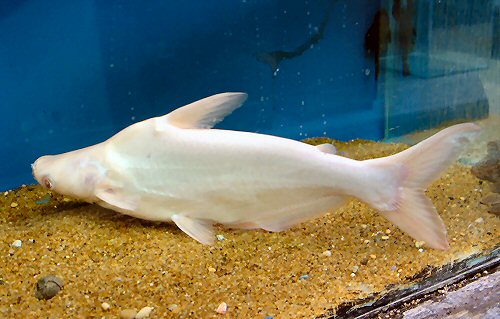SCOTCAT.COM
your internet guide to all things catfish
| In Defense of the "Iridescent Shark" |
by Michael Hissom |
Pangasius hypophthalmus
Well, hurricane Floyd and life made other plans and by the end of the summer I couldn't get the damage done to my greenhouse by the hurricane fixed so the shark had to go into a 125 gallon tank along with a large elephant nose fish, three 6" freshwater flounders I had raised from fry, a school of about a dozen inland silversides, a dragon goby, several blue spotted sunfish, and various other fish that came and went over what was to become seven years. I kept that shark for seven years until a catastrophic event caused the aquarium to fail killing all the fish. The shark had been 12" when I rescued it. It never grew any larger. It was very alert, ate well, often fighting with the elephant nose over the black worms I feed the tank. He also ate a plant based pellet along with a few earth worms from time to time. The shark was 12" long when I got him but in the following seven years he never displayed any health problems nor did he hurt himself by crashing into the walls of the tank like I had been told was inevitable with these fish. He was a great pet and never showed any signs of stress or any other problems. My question is this, if the fish did that good after being stunted at 12" growth why is it necessary for a fish to attain some glorified perfect size in captivity for him to be healthy and happy? While I wouldn't expect a Pangasius hypophthalmus to do well in 20, 30, or even a 55, he did do well in a 125 and to be honest in my 45 years of aquarium keeping I have seldom had a fish that had as much personality or that I got so much enjoyment from as I saw from this fish. To say these fish cannot be a good aquarium fish is so misleading it's not even in the realm of truth. Yes a Pangasius hypophthalmus needs a big tank but if it is raised in a 55 or so sized tank and when it is about 10 to 12 inches or so it is transferred to a 100 or larger tank it can be a great pet. The key is to keep it in a place where it can get used to having action going on in the room around it. A good quality live food with a good prepared supplement should be given and it should have tank mates that contribute by having a calming influence. i.e. dither fish. In other words if they are kept in pretty much the same way as any fish should be and taken care of in a quality manner as you would any fish you intended to keep for a long time, they can be kept.
Pangasius hypophthalmus - albino
I did some looking into this phenomenon of fish being stunted and I found it happens even in the wild when fish have environmental problems. Now that I am looking for this effect I can see it happening in many other fish. It happens easier in some fish than others but I would say it happens in gold fish more often and easier than any others. This effect is real, I had to overcome many preconceptions to be able to see the effect. I was at one time so convinced that no large fish could have it's size controlled without having it's health damaged that I refused to see it any other way. But now I see it can and often does happen. I think the directions I gave are the best way to bring this about in any fish. Some will be more prone to this effect than others but if you are patient it can work to some extent in nearly all fish. Iridescent sharks are not big predators and eat mostly plant material and insect larvae. I've never seen one catch even a tiny cardinal tetra. I would have to assume a one meter specimen might eat a tetra but I would have to see it. Mine was kept with several tiny fish and it never bothered them at all. I am guilty of assuming that most hobbyists know what to expect from a fish like an iridescent shark since plenty of info about them is available all over the Internet or by books. Michael
Hissom Images: Top: Leigh
Murphy |
If you would like to contribute an article, please e-mail me. You will of course be credited for your work.
If you would like to donate any denomination of money to the site just click the above link button. All proceeds will go to running the site and hopefully to keep it going for a few years yet.
Print or e-mail this article below



